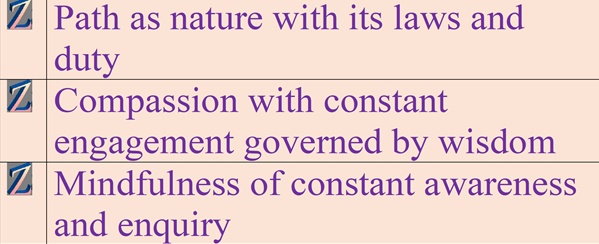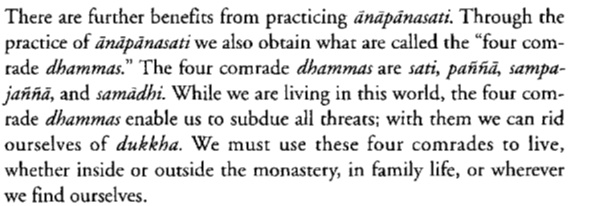5) The Protection of the 5 Dhamma Comrades

On p103 of Mindfulness with Breathing, Venerable Buddhadasa says:-

Elsewhere Buddhadasa talks of also obtaining the 4 Dhamma comrades, as an elder it is necessary to consider being pro-active concerning their obtaining. But before that can be considered it is necessary to explain why the title is 5 Dhamma comrades - in other words to explain to some extent why I have added love as a Dhamma Comrade. In later studies in the Prajna portal it became clear to me that there was an inimical relationship between patriarchy and love, and this has led to an emphasis on wisdom - or better understood as a lack of emphasis on love. Despite my great respect for Buddhadasa I felt it necessary to add love as a Dhamma comrade. I see this lack of emphasis as an omission, and when I became aware I had to come back and make changes - changes discussed in Ch15 - Embodying the love-wisdom balance.
As seekers developing a practice it is not necessary to go into great discussion but it is necessary to look into developing love as part of your practice - this development is so essential I have called love a Dhamma conrade.
And the reason for developing the 5 Dhamma comrades is protection against ego.
Let us examine a possible scenario. Following the 4 tetrads of anapanasati-bhavana as described here, it is possible to experience jhana states during the second tetrad; this is samadhi. These states are empowering. What happens if these states have empowered without protection? They could empower the ego. If there is no foundation in wise and loving action, then instead of the path being empowered the ego could step in and decide that it can use that power. This is a problem of what I have previously called glamour. People discussing the path promoting the jhanas under whatever name are discussing power, and the ego likes nothing more than power to promote itself. The path is not concerned with power but it is concerned with bhavana – continuous ongoing bhavana.
As elder there is a need to provide protection against this egoic appropriation – this egoic power grab. It becomes necessary to develop the other 4 Dhamma comrades (samadhi develops the jhanas) to protect the student from this possible power grab.
The name “Buddhadasa” is an anglification(?) from the Thai name he took, and the Thai name means “slave to the Buddha”. This means that anapanasati-bhavana is part of the bank of knowledge and practice known as Buddhism. In order to provide this protection pro-actively we turn to Buddhist knowledge and practise, the protection we want is primarily sati but also sampajanna – at this stage the beginnings of love and wisdom being put into practice.
For protection we need to be mindful of the dangers of ego. During the 3rd tetrad we develop strategies to remove attachment as ego but it might not be safe to wait until then, and “hope” that the jhanas don’t empower the ego. At the same time reshaping the ego through right action needs to start, and of course right action is the beginnings of wise action – panna and sampajanna.
During the 1st tetrad we introduce the 5 precepts. This starts to train the mind into accepting that what is sila – virtuous – has to be put into practice. It is a process of controlling the ego. At the same time as controlling the ego in this way the elder makes the student constantly aware of the dangers of ego. This will happen naturally as the ego constantly tries to deceive the student – delusion (one of the three kilesa), and the elder must point this out.
At the end of the 1st tetrad before introducing the power of the jhanas in the 2nd tetrad, the elder focusses the mind into wise action through an understanding of the 4 Noble Truths. Through the 8-Fold path right mindfulness itself is actively developed, the elder can focus on this in order to protect from the ego. Sila-consciousness-in-action comes from right action, speech and livelihood. By the end of this focus on the 4NT there will be a recognition of clinging, that ego develops from clinging, and ending this clinging can bring an end to suffering by following the 8-Fold path.
There will also be the beginning of wise and loving action (love, panna and sampajanna) – the understanding that love and wisdom are necessary but that it is not enough without applying it to daily life.
I have a final practical note concerning the problems of western education – western education is now a global model but this note primarily concerns western students although not exclusively. This education system, to use a Krishnamurti phrase, fills the “contents of consciousness”. Education is not concerned with the “getting of wisdom” but with the filling of intellect with content (facts etc.). This focus on intellect greatly bloats the ego with attachments and this content effectively creates a barrier to sampajanna. Intellect promotes the ego that it is “all in the mind”, and we become overly active within the intellectual ego – attaching to the khandha-sankara. This active focus within the intellect creates a barrier to sampajanna so that whatever little wisdom is obtained at this stage does not get translated into action. The natural connection in doing – being wise and acting out that wisdom – cannot break through the intellectual barrier. This is the stereotype absent-minded professor but is far more widespread than such isolated individuals.
Through the practice of the 5 precepts and the 4 Noble Truths the student will be trained into using the empowerment of jhanas in wise action. At the same time the student will be protected by sati from the ego appropriating the power of the jhanas.
Next Ch6 Deepest Acceptance/Companion Contents/Previous Ch4 Teaching Methodology
|





